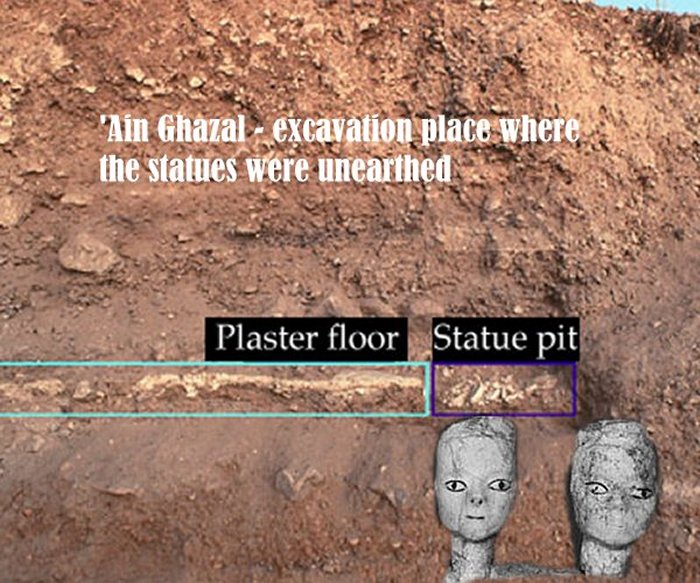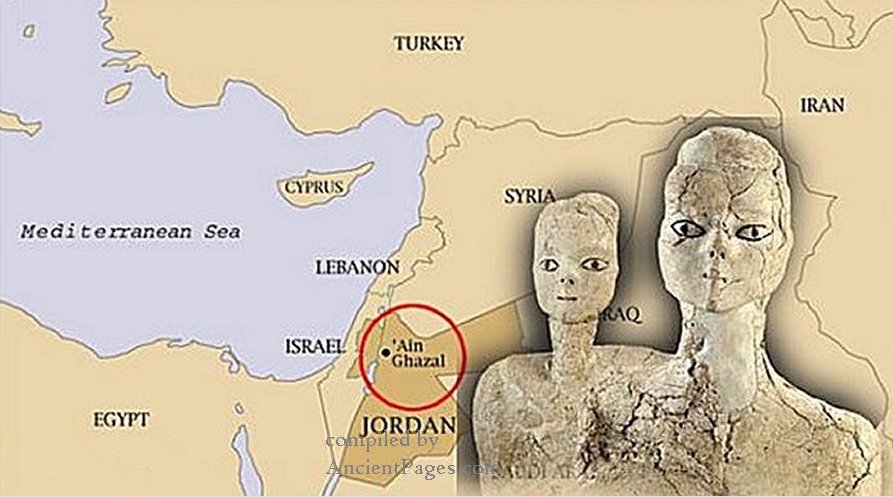A. Sutherland - AncientPages.com - Who were these beings who visited prehistoric Jordan, a place at the crossroads of the oldest human cultures?
The statues along with two of the oldest temples in the world - dating back more than 8,000 years were discovered during excavations at the Neolithic settlement 'Ain Ghazal, in the vicinity of the modern capital of Jordan, Amman in 1983.
Mysterious lifelike, nearly life-size plaster statues are in many ways anonymous; they lack human arms and typical indications of gender.
'Ain Ghazal - a large village of farmers, herders, and hunters - is considered to be established around 7250 BC and later abandoned around 5000 BC.
Archaeologists discovered evidence of multiroomed houses made of stone with timber roof beams, plastered walls, floors, and courtyards. They also excavated cooking hearths with food remains, stone tools, stone and clay figurines, and graves.
Ain Ghazal was settled in about 7200 B.C., in the Neolithic period. Scholars divide this period into Pre-Pottery Neolithic (c. 9000–5500 B.C.) and Pottery Neolithic (c. 5500–4000 B.C.).

Jordan statues. Photo credits: Arthur M. Sackler Gallery Smithsonian Institution; source2
It flourished in the Pre-Pottery Neolithic for almost 2,000 years. By 6200 B.C. the settlement had grown to occupy nearly 40 acres, almost four times the size of contemporaneous Jericho, only 30 miles away.
Indeed, Ain Ghazal was one of the largest “cities in the Neolithic Near East.
In 1984 archaeologists examined the side of a bulldozer cut made some years earlier during highway construction. They found the edge of a large pit about 2.5 meters under the surface, in which fragments of plaster statues were visible.
The more than 30 human figurines recovered in the prehistoric village of Ain Ghazal, had several strange features. Almost none had both head and body; there were either bodiless heads or headless bodies.
This practice is attested not only at Ain Ghazal but also at other sites in the southern Levant.
All of these figurines are created in clay containing limestone powder mixed with lime plaster.
They are among the most ancient monumental artifacts ever found. Their size is varying from small, between 2 and 3 feet in height to almost life-sized figures.
Their large, elliptical in shape eyes are unique and small ears indicate that these are depictions of an unknown ancient race witnessed by the local population of prehistoric Jordan.
Many fragments of these very ancient artifacts were out of place and badly damaged and putting the statues back together was difficult and time-consuming.
Sometimes, the broken edges of two fragments could be easily matched like the pieces of a puzzle. But the edges of many fragments were heavily eroded, and this was not always possible.
Left: D. Nordeck/Smithsonian Institution; Right: Photo credits: Arthur M. Sackler Gallery Smithsonian Institution
In some cases, the reed or twine impressions preserved on the interior surfaces of the statues could be used to determine where joins should be made. Once joining fragments were identified, conservators used a special kind of adhesive to reattach them. The adhesive can be removed if any further preservation work is needed in the future.
Even after many months of careful work, the statues could not be completely put back together. Conservators filled in gaps with a "dough" made of acrylic resin, glass micro-balloons, and cellulose powder. They tinted the new areas with watercolors to help viewers distinguish them from the ancient fragments.
Almost nothing is known about these mysterious statues and the Neolithic artists who made the statues as well.
(more about images -source)
Written by – A. Sutherland - AncientPages.com Senior Staff Writer
Copyright © AncientPages.com All rights reserved. This material may not be published, broadcast, rewritten or redistributed in whole or part without the express written permission of AncientPages.com
Expand for references






